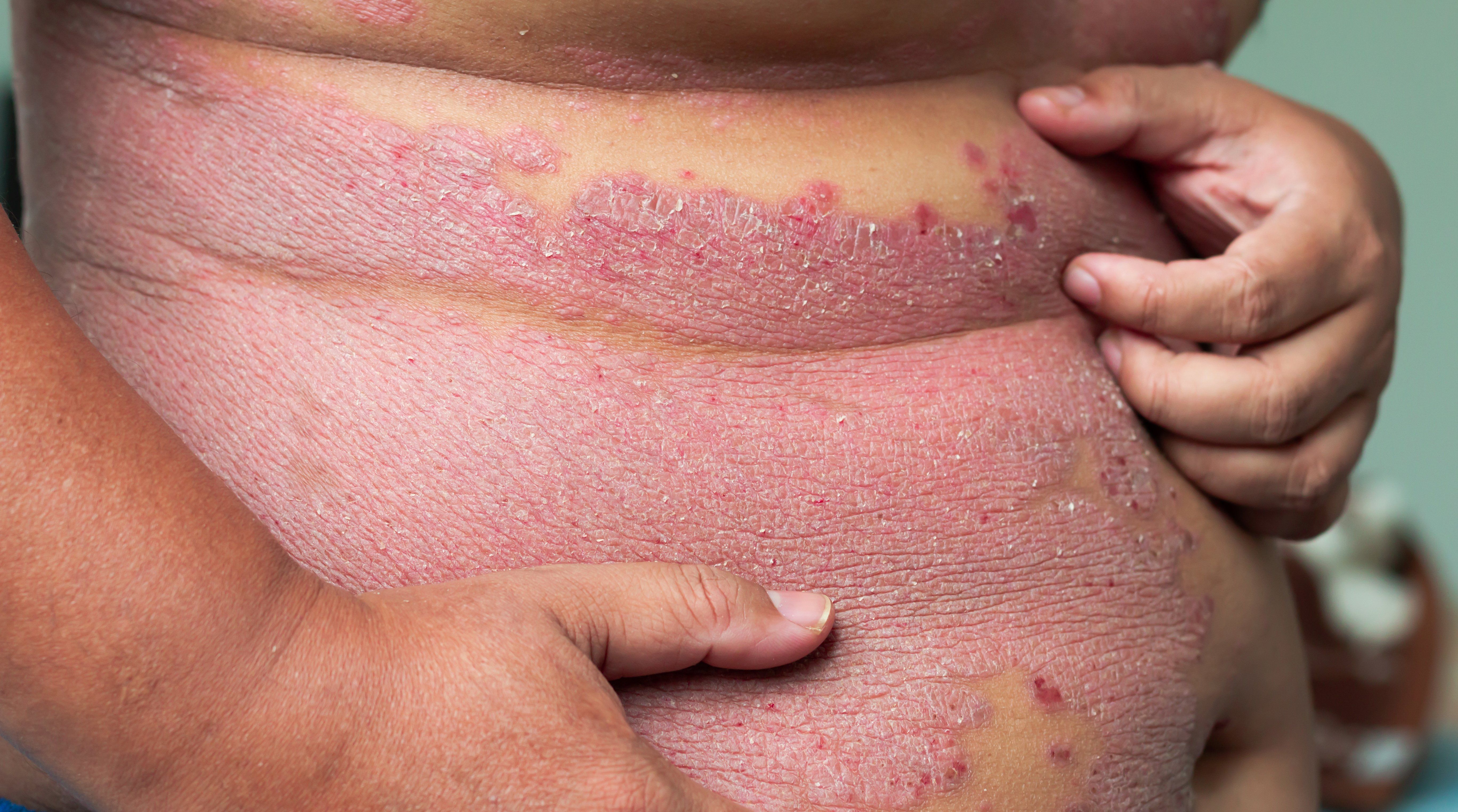- Case-Based Roundtable
- General Dermatology
- Eczema
- Chronic Hand Eczema
- Alopecia
- Aesthetics
- Vitiligo
- COVID-19
- Actinic Keratosis
- Precision Medicine and Biologics
- Rare Disease
- Wound Care
- Rosacea
- Psoriasis
- Psoriatic Arthritis
- Atopic Dermatitis
- Melasma
- NP and PA
- Skin Cancer
- Hidradenitis Suppurativa
- Drug Watch
- Pigmentary Disorders
- Acne
- Pediatric Dermatology
- Practice Management
- Prurigo Nodularis
- Buy-and-Bill
Article
Fatty liver disease first in psoriasis
Author(s):
Psoriasis is associated with a host of comorbidities, such as obesity and the metabolic syndrome. In this study, researchers show that fatty liver disease is often the first sign of worsening health.
Psoriasis is associated with a host of comorbidities, such as obesity and the metabolic syndrome. In this study, researchers show that fatty liver disease is often the first sign of worsening health. (©AdobeStock_nikkikii_psoriasis213755198)

Researchers writing in the Journal of Clinical and Aesthetic Dermatology have documented an association between psoriasis, nonalcoholic fatty liver disease and the metabolic syndrome.
"Nonalcoholic fatty liver disease seems to occur more frequently in patients with psoriasis,” said study co-author Lisa W. Martin, M.D., of George Washington Medical Faculty Associates. The study appears in the June 1 online issue of the journal.
This was an observational study of 151 adults (mean age 44.2 years) with psoriasis and 51 controls. Nonalcoholic fatty liver disease was found in 21.2% of psoriasis patients as compared to 7.8% controls, but there was no association after age, sex and body mass index were factored into the final analysis.
Patients with nonalcoholic fatty liver disease were more likely to be obese and have hyperglycemia and hyperlipidemia, which are associated with the metabolic syndrome.
Psoriasis patients with nonalcoholic fatty liver disease had higher levels of glucose, aspartate aminotransferase, alanine aminotransferase, triglycerides and very-low-density lipoprotein cholesterol.
"Patients who have psoriasis, nonalcoholic fatty liver disease and some of those components of metabolic syndrome, may be at higher risk for cardiovascular disease. So, we would want to treat them more aggressively for these risk factors, and for lifestyle factors as well,” she said.
Even though psoriasis patients had higher BMI values showing they were at risk for obesity, only two patients were confirmed to have metabolic syndrome. The patients also had mean values for HDL, triglycerides and glucose that were below the minimum criteria for metabolic syndrome.
The findings suggest a correlation between heart disease and the severity of psoriasis. For example, it found that “for every 10-percent increase in high-sensitivity C-reactive protein (CRP), PASI score was found to increase by two percent.” And, for every one-unit increase in HDL, PASI scores decreased by 2.1 percent.
Nonalcoholic fatty liver disease is most often not associated with any signs or symptoms, but in some cases, it can lead to cirrhosis which can be life-threatening.
Psoriasis patients should be assessed for other systemic illnesses that could contribute to liver disease and atherosclerosis. "If patients have these markers, it is recommended they follow up with their primary care physicians to try to reduce their risk of cardiovascular disease and liver disease," she said.
The study's findings fit well within the context of previous research, said Dr. Martin. For example, an Indian study published in the June 2012 Australasian Journal of Dermatology found nonalcoholic fatty liver disease rates of 17.4% in patients with psoriasis, and 7.9 percent in controls. An Italian retrospective study published in the May 2009 Journal of Hepatology showed that nonalcoholic fatty liver disease occurred 19 percent more often in patients with psoriasis (although prevalence rates were 47% versus 28%, respectively), and that nonalcoholic fatty liver disease correlated with higher PASI scores. However, an American study published in the October 2012 issue of Hepatology showed no significant difference in nonalcoholic fatty liver disease prevalence between patients with psoriasis and without.
NEXT STEPS
Dr. Martin suggests assessing psoriasis patients for the presence of other systemic illnesses that could contribute to liver disease and atherosclerosis. "If patients have these markers, it is recommended that they follow up with their primary care physicians to try to reduce their risk of cardiovascular disease and liver disease," she said.
REFERENCE
Olabola Awosika MD MS, Misty G Eleryan MD, Monica Rengifo-Pardo MD, Lindsay Doherty MS, Lisa W Martin MD, Alison Erlich MD MHS. "A Case-Control Study to Evaluate the Prevalence of Nonalcoholic Fatty Liver Disease Among Patients with Moderate-to-Severe Psoriasis," Journal of Clinical and Aesthetic Dermatology. June 2018.





